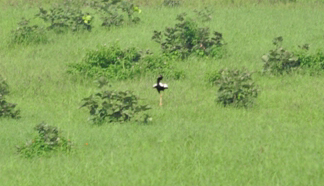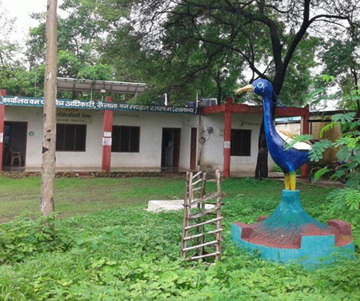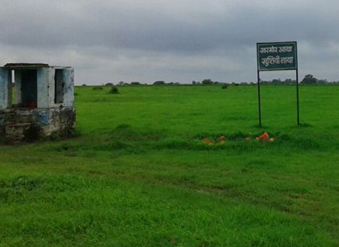Sailana : The last hope for the Endangered Lesser Florican in Madhya Pradesh.
-Ajay Gadikar
The Lesser Florican (Sypheotides indicus) known as Kharmor or Likh is an endemic bird species found in the Indian subcontinent.
The Lesser Florican is also a threatened bird species and is classified as endangered (EN) in the Asian Red Data Book and protected under Schedule I of the Wildlife Protection Act (1972) of India. In Madhya Pradesh special protected areas are set aside
to conserve the Lesser Florican, like the Sardarpur Wildlife Sanctuary in the Dhar district and the Sailana Wildlife Sanctuary in Ratlam district.
It’s a bird of grasslands and visits at different areas of Western M.P. with the onset of southwest monsoon for breeding. Little is known about its whereabouts during the non-breeding period as the bird is usually spotted only during the breeding season.
It is best known for its aerial courtship display when the male makes a series of spectacular jumps to a height of 1.5 to 2 m. around 500 times in a day.
The Lesser Florican is omnivorous and eats invertebrates like grasshoppers, dung beetles, caterpillars, centipedes, worms and plant parts like crop shoots, leaves, herbs and berries.
The M.P. forest department with the help of Scientists from WII and BNHS is trying their best to conserve this bird habitat and save the bird from the clutches of extinction.
Lesser Florican displaying
Threats
1. The Lesser Florican is primarily threatened by hunting and poaching. Its population also get affected adversely by drought in its breeding areas.
2. Today a major threat to the Lesser Florican is uncontrolled cattle grazing in the grassland habitat between July to October which is also its breeding time. A large number of local livestock graze in the areas creating problem for the conservation of
habitat.
3. As insects and crop parts form a major part of the florican’s diet, excessive use of pesticides indirectly kills the bird it or affects its breeding.
4. The increase in the population of Bluebull in this area has always been a point of concern for the breeding females, many herds of bluebulls roam in this area which accidentally damages the eggs of lesser floricans.
5. Disturbance from unethical photography, because of revolution in digital photography and social media many people found engaged in unethical photography.
6. Illegal mining near the protected area of the sanctuary unsettles the bird coming to breed in the area.
7. Stray dog’s population has also increased considerably in all breeding areas of florican which also causes threat to this bird.
8. Inadequate knowledge of current distribution, population status, demography, movement-dispersal and habitat use.
9. New Wind Mill installation near the sanctuary areas is also causing an indirect threat to the bird.

Lesser florican habitat
Conservation Initiatives
The initiatives taken by the forest department are to give prize money to any field farmer who spots a lesser florican in his fields and safeguard the bird. Also a compensation is provided to any farmer if a lesser florican lays eggs in his field.
Last year the forest department has started providing seeds of many indigenous crops free of cost to the farmers, so that the farmers in the area should divert from growing soya bean as the monsoon crop and shift to some indigenous crops cultivation.
Creation of a cattle camp near Sailana Sanctuary by the Forest Department, wherein more than 600 head of cattle were stall-fed, resulted in a decreased grazing pressure on the grassland habitat and also helped in a significant rejuvenation of vegetation
in florican habitat.
A large scale public movement was undertaken by the locals and NGO to save the sanctuary from the illegal mining and construction activities since last three years and legal case were filed in Green Tribunal court against the construction company.

The forest office in Sailana
A new Conservation strategy: The use of organic farming.
Habitat degradation due to excessive use of chemical fertilizers and pesticides in agriculture owing to depleting soils is one of the major threats to the existence of Lesser floricans as well as other creatures existing on the grass land ecosystem. These
chemicals are killing a variety of insects and worms that constitute the food of the birds.
It is therefore necessary to educate, encourage and support local people to shift to organic farming, or the least minimize the use of chemical insecticides in preferred breeding grounds of floricans.
A lot of villages in the area have now taken up organic farming which is a good sign.

The lesser florican sanctuary
Conclusion
The common and main reason for depleting number of lesser floricans can be summed up as the loss of their habitat, i.e. grasslands, grasslands getting converted to cultivated fields due to the ever increasing demand for food grains.
The change in the crops that’s being cultivated and the cultivation of Urad and other cereals replaced by cultivation of Soya beans over the years has also emerged as a grave threat for the floricans in all the areas.
Sailana Sanctuary in Ratlam district today still holds a very good chance to provide a safe and secure place for the visiting floricans in coming years. Floricans arriving here for breeding must be provided safe and secure environment to breed, as this
is a very important and among the last few breeding grounds left for this bird.
The Ratamba forest patch in the petlavad range of Jhabua has come up as a second ideal habitat for the endangered lesser florican in Madhya Pradesh. Lesser Floricans sightings are recorded here regularly here since last 5-6 years.
As the Sardarpur sanctuary has been devoid of lesser floricans since last three years this area should be given more weightage to ensure that the population of lesser floricans should not dwindle further in Madhya Pradesh.
(Text and photographs by Ajay Gadikar. Ajay Gadikar is an Ornithologist from Indore.)